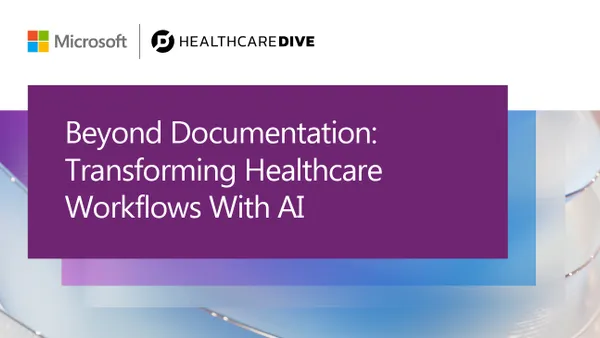Healthcare has weathered regulation waves before. HIPAA, HITECH, interoperability mandates, and price transparency rules all arrived with uncertainty, and each reshaped the industry for the better.
AI is next on that horizon – and the implications for health plans are both significant and imminent.
That’s particularly true for behavioral health programs, where the maturity of analytics simply isn’t on par with the rest of medicine. Health plans can model physical health outcomes; they can predict complications and costs well before they occur, with incredible precision. In behavioral health, however, those same analytical tools often fall short. That’s because behavioral health and physical health data are often siloed, risk models haven’t been trained to factor in the impact of unmanaged behavioral health conditions, and behavioral health hasn’t traditionally been a part of healthcare quality measurement and improvement initiatives.
AI’s promise in behavioral health lies in its ability to pull needles of insight from haystacks of unstructured data – using algorithms to identify emerging risks and optimize interventions in seconds rather than relying on weeks of manual review. But as these models move from experimental to essential across the healthcare industry, regulators are inevitably stepping in to ensure they’re safe, equitable, and explainable.
New regulatory packages are sure to accelerate the need for rigor in this space, pushing plans to treat behavioral data with the same depth, structure, and accountability as any other clinical domain. This moment presents an opportunity to use existing data more efficiently, strengthen trust, and improve care quality at scale.
That’s not a reason to hesitate or slow down. It’s a reason to prepare. Health plans that invest now in transparency, documentation, and strong model governance will be ready to lead when the rules arrive.
What we know (and don’t know) about upcoming oversight
Regulators have already signaled what’s coming. The White House’s AI Bill of Rights, evolving state-level legislation and agency frameworks, and congressional initiatives all point toward a future defined by AI explainability, accountability, and data integrity. The specifics will vary, but the intent is clear: organizations must understand how their algorithms are built, what data they are training on, and how outputs are validated. They must also be able to audit for bias and assign ownership for decisions influenced by AI.
The question isn’t if those expectations will become law. At this point, it’s when – and that’s where behavioral health poses a unique challenge.
The “behavioral health blind spot” makes taking steps toward transparency now even more critical. A one-size-fits-all regulatory framework could easily overlook the nuances of behavioral health, unless health plans proactively build safeguards into their models.
The FDA’s recent guidance on AI regulation offers a glimpse of how behavioral health AI models may soon be held to account. In one case, researchers proposed using AI to identify low-risk patients who could forgo 24-hour monitoring while receiving a drug with life-threatening side effects. The FDA classified that system as “high-risk AI,” requiring strict validation because its output directly influenced life-or-death clinical decision-making.
Behavioral health operates in the same high-stakes arena. Algorithms that predict suicide risk, assess depression severity, or determine care intensity are all influencing critical decisions, such as who receives immediate outreach, who gets priority follow-up, and where resources get allocated. If the FDA demands this level of scrutiny for clinical AI, similar oversight for behavioral health models is only a matter of time.
If health plans want to lead in behavioral health AI, striking the delicate balance between protection and innovation will be key. Responsible use of behavioral health data can uncover latent risks early, improve coordination, and enable proactive intervention, but only when models are governed with the same rigor that regulators are coming to expect across healthcare.
Building a future-proof AI framework
Preparing for AI regulation requires putting into practice the same habits that good data science already demands. Every model should be transparent in its design, auditable in its performance, and ultimately owned by the organization that relies on it.
Health plans don’t need to wait for a federal mandate to start preparing for AI regulation. Future-proofing isn’t about predicting what’s going to happen as much as it’s about maintaining discipline. Documenting data sources and decision logic, establishing multidisciplinary governance teams, and partnering with organizations that share a steadfast commitment to transparency are all practical steps health plans should be taking today.
These steps not only build regulatory readiness but also create a lasting competitive advantage. Health plans that can clearly explain how their algorithms work will be the ones that move fastest when regulation takes effect. That transparency builds confidence not only with regulators but with providers, members, and partners across the ecosystem.
Regulatory clarity will come, and is sure to continually evolve. The health plans that act now won’t have to scramble – or pay a price – when the rulebook is published. They’ll already be operating with the discipline those rules will demand.
That’s the philosophy behind NeuroFlow’s BHIQ analytics solution. While many AI vendors deflect questions using “proprietary algorithms” as a shield, that answer won’t satisfy regulators – and it shouldn’t satisfy health plans, either. BHIQ is built for transparency: health plans can see and explain how predictive features connect to real clinical outcomes. With BHIQ, model architecture, feature selection, and training data composition are all fully documented, meaning teams are able to validate representativeness and monitor for any drift over time.
In a fast-evolving regulatory landscape, BHIQ meets the credibility standards regulators are coming to expect for AI models, helping health plans operate with clarity and confidence..
Health plans that treat regulatory readiness as part of their long-term AI strategy will not only raise the bar for what providers and members can expect; they’ll lead the way in defining the next era of innovation.
Learn more about how BHIQ can help your plan build future-proof predictive models.










